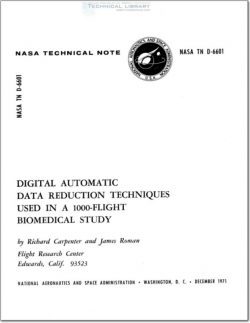NASA-TN-D-6601

- Version
- 119 Downloads
- 838.67 KB File Size
- 1 File Count
- June 16, 2016 Create Date
- June 16, 2016 Last Updated
Digital Automatic Data Reduction Techniques Used in a 1000-Flight Biomedical Study

Modern sensing and recording techniques have made it possible to record physiologi—
cal information continuously during flight (refs. 1 and 2). Continuous physiological in—
formation has also been collected over the years during centrifuge programs. The use
of continuous monitoring has resulted in the accumulation of vast quantities of data. Be—
cause manual data reduction is prohibitively expensive, except for selected portions of
data, and because computer programs specifically designed to handle and reduce large—
scale collections of continuous physiological information were not available until a short
time ago, most of these data have never been completely reduced. In fact, some have
yet to be viewed.
The use of computers is the only practical way to obtain information from medical
data recorded continuously in flight; thus, the development of pertinent data handling,
data reduction, and data evaluation techniques is of importance to aerospace medicine
and, perhaps, to clinical medicine.
Techniques were required to process physiological data obtained in a low signal—to-
noise—ratio environment. Thus the possibility of manually reducing the data obtained in
a 1000—flight study from oscillog‘raphic tracings was investigated. After a few simple
calculations it became apparent that the amount of data accumulated during the flights,
each with a duration of 100 minutes, would be overwhelming: of the order of 1 X 107
heartbeats and approximately 1 X 106 respiration cycles, for example. Therefore a con—
certed effort was made to provide the investigators with an easily interpretable format
for each flight. This paper discusses the computer techniques developed at the Flight
Research Center to reduce the physiological data which were collected in over 2000
hours of flight.
A literature search did not reveal any techniques or hardware specifications for
reducing physiological data obtained in a low signal—to-noise—ratio environment.
Therefore, investigation was required to determine applicable data reduction techniques.
Investigations were conducted using a system consisting of an on—line computer
which had direct conversation capability between the investigator and the computer,
together with the capability for reading in large quantities of data. This system con—
sisted of a high-speed computer at a location remote from the user and terminal
equipment (i. e. , input and output equipment) at the investigator's location. The
input—output data flow was accomplished via telephone lines to the computer complex.
This type of on—line computer greatly facilitated the development of the automatic data
processing technique.
| File | Action |
|---|---|
| NASA-TN-D-6601 Digital Automatic Data Reduction Techniques Used in a 1000-Flight Biomedical Study.pdf | Download |

Comment On This Post